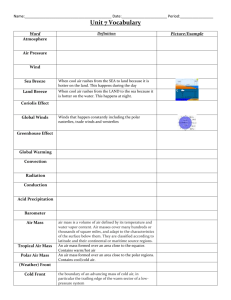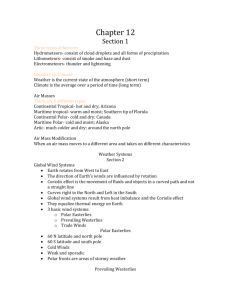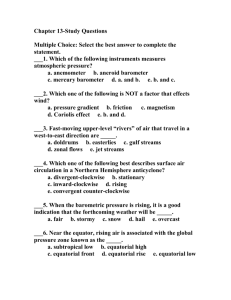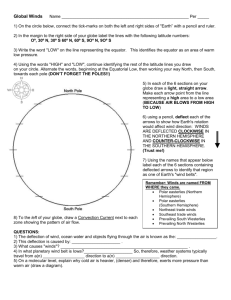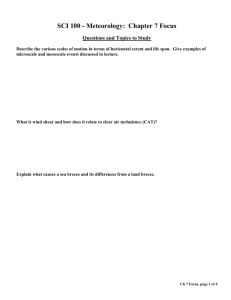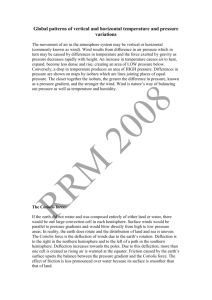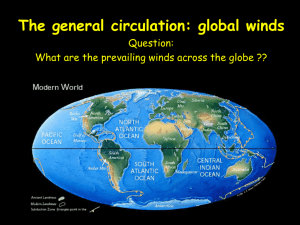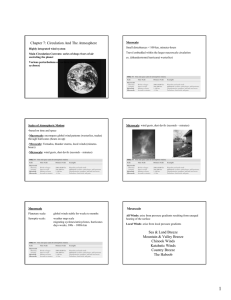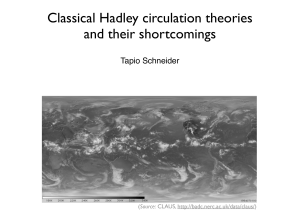General Atmospheric Circulation
advertisement
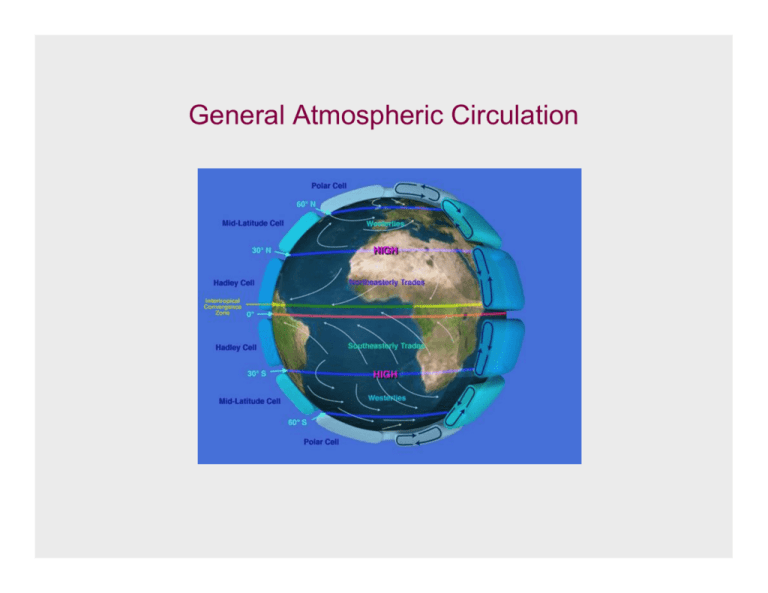
General Atmospheric Circulation Take away Concepts and Ideas Global circulation: The mean meridional (N-S) circulation Trade winds and westerlies The Jet Stream Earth’s climate zones Monsoonal climate Hurricanes Where we left off on Monday … Atmospheric motion is driven by uneven heating of the planet. Atmosphere (and ocean) moves excess heat from tropics to poles Flow is determined by balance between pressure gradients and Coriolis force Why is this important? Heat transport by the atmosphere and ocean! Pressure gradient force F (east east) = - (Δp / Δ x) / ρ F (north-south) = - (Δ p / Δ y) / ρ y High/low pressure? x High/low pressure? High/low pressure? Think of pressure fields like a topo map High pressure “wants” to move to low pressure in the most direct way. L H L H L If the Earth didn’t rotate air would flow H --> L. H H L L L Pressure gradient force …. If there was no earth rotation F is proportional to Δp / Δy and Δp / Δy y L H x L H L Now, enter the Coriolis effect Artifact of Earth’s rotation An apparent force which acts on motion on the earth’s surface Conservation of angular momentum Fcoriolis = 0 on equator, increases poleward Coriolis Force Cons. of Angular Momentum Geostrophic Balance … the pressure gradient force (∆P) is balanced by Coriolis force. Applies to frictionless flow. NORTHERN HEMISPHERE Pressure gradient force …. WITH earth rotation Geostrophic Circulation L H L H L Interesting link… Surface Pressure today L H L H http://weather.unisys.com/surface/sfc_con.php?image=pr&inv=0&t=cur&expanddiv=hide_bar … and the winds Strong winds where ∆P is greatest http://www.wunderground.com/US/Region/US/2xWindSpeed.html Application to Earth Geostrophic flow gives rise to banded circulation zones Trade Winds and the Intertropical Convergence Zone (ITCZ) ITCZ Hadley Cells Tropical-Subtropical Hadley Cells Trade winds Tropical-Subtropical vegetation patterns Rising limb of Hadley Cell (ITCZ) = Equatorial Rainforest Descending limb of Hadley Cell = Deserts Global Vegetation Circulation Cells Polar Cell Ferrell Cell Hadley Cell Wind Zones Polar Easterlies Mid-lat Westerlies Trade winds Mid-Latitude Westerlies Westerlies = blow from west to east Winds are highly variable, unsteady, particularly in winter (why?) Polar Easterlies Easterlies = blow from east to west Winds are v. cold, more stable Jet Stream Upper level air flow Very fast High altitude Variable Why is there a Jet Stream? 5 km altitude Equator Occurs where warm and cold air meet North Pole Jet Stream Jet stream Hadley circulation is very deep in tropical troposphere (15 km) Aloft, the air must return toward poles, carries with it equatorial angular momentum. Northward motion is deflected to right (east) by Coriolis. No friction … very fast! Jet stream Monsoonal climate Why does it rain? Summer Why is it dry? Winter (rain season) (dry season) Largest monsoon regions: S. Asia & N. Africa Winter Dry Season Summer Rainy Season Cyclones (Hurricanes and Typhoons) Develop around deep LOW pressure cells Cyclonic flow = around low pressure (CC in NH) Intensity due to added power from condensation Birthplace of Atlantic Hurricanes How to make a hurricane Hurricane basics - Forms over warm waters - Cyclonic flow around deep low - Alternating bands of convection/subsidence - Water condensation important energy source - Loses power over land Katrina (Aug. 25, 2005) Trade wind belts: In the tropics, on both sides of the equator, lies a wide region where winds blow from east to west (easterlies) with a slight equatorward tilt. This region is named the trade wind belt, because of the steadiness of the air flow here. Intertropical Convergence Zone (ITCZ): The trade winds from the Northern and Southern Hemispheres converge into a narrow belt close to the equator, nowadays generally referred to as the Intertropical Convergence Zone (ITCZ). The convergence of the trade winds results in rising motion of the colliding air masses (to obey the law of mass continuity). Midlatitude westerlies: North and south of the trade wind belt (in the Northern and Southern Hemispheres, respectively) lie regions where winds tend to blow from west to east (westerlies), and are therefore referred to as the westerly wind belts. Here the winds are highly variable and unsteady, especially so during winter. Subtropics: Between the trade wind regions lie the subtropics - regions of divergence and subsidence, where sunny weather with little clouds and no rain prevails. Most of the Earth’s desert regions are found near 20-30° north and south of the equator. Polar easterlies: Poleward from the westerly wind belt, winds with a generally easterly component prevail. The air here is cold, dry and stable, especially during winter, and is accompanied by subsidence from above. Polar front: The convergence zone between polar easterlies and midlatitude westerlies is referred to as the polar front. It separates between the cold (and dry) polar air, and the relatively warm (and more humid) midlatitude air. The polar front can be thought of as the average expression of the transient frontal systems that move along with midlatitude cyclones.
